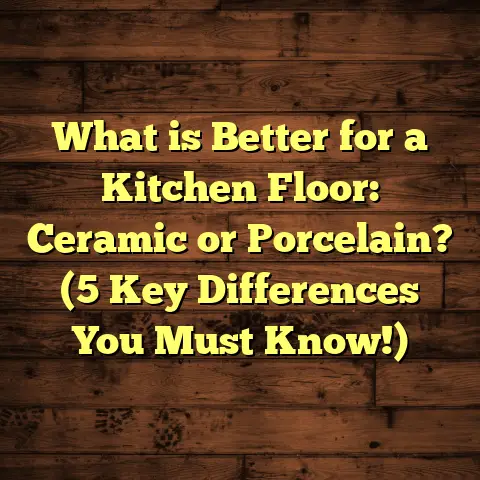What is Oiled Oak Flooring? (5 Benefits You Didn’t Know About!)
Have you ever stepped onto a wooden floor and felt an immediate sense of warmth and comfort that just seemed to wrap around you? I remember the first time I encountered oiled oak flooring, that exact feeling hit me hard. It wasn’t just the look; it was the way the floor felt beneath my feet—soft, natural, and inviting. If you’ve ever wondered why some wooden floors keep their charm for decades while others start to look tired and worn out quickly, oiled oak may be the secret you didn’t know about. Let me take you on a journey through what oiled oak flooring is and share five surprising benefits that could change how you think about your next flooring project.
What is Oiled Oak Flooring?
Oiled oak flooring is a type of hardwood flooring made from oak wood planks that have been treated with oil to protect and beautify the surface. Unlike traditional hardwood floors sealed with polyurethane or varnish, oiled floors absorb the oil deep into their fibers rather than creating a hard layer on top. This process highlights the natural grain of the oak and gives the floor a matte, velvety finish.
Now, you might be asking: why oil? Why not just varnish or lacquer like most other floors? The answer lies in both aesthetics and function. When you oil oak wood, you’re allowing it to breathe. The oil penetrates the wood and nourishes it, protecting it from within while preserving its natural feel. This results in a floor that is not only durable but also rich in character.
The Oil Application Process
The type of oil used matters a lot. Common options include natural oils such as tung oil, linseed oil, or specialized hard wax oils designed specifically for hardwood floors. These oils soak into the wood’s pores and then harden, creating a protective barrier that’s flexible rather than rigid.
The application is usually done in several thin coats. After sanding the oak planks smooth, the first coat of oil is applied and left to soak in for several hours. Excess oil is wiped away to avoid sticky surfaces. Then additional coats are applied until the desired finish and protection level are achieved.
One thing I noticed during my installations is how this method brings out little details in the wood grain that varnish can sometimes mask with its glossy finish. In fact, in one recent project, the client was amazed at how the knots and growth rings stood out so vividly once oiled.
A Glossary of Terms You Might Hear
- Hard Wax Oil: A blend of oils and waxes that provides both penetration and surface protection.
- Matt Finish: A non-glossy finish that reduces light reflection.
- Janka Hardness: A scale measuring wood hardness; oak rates about 1360.
5 Benefits of Oiled Oak Flooring You Didn’t Know About
Let me share some benefits that surprised me when I first started working with oiled oak floors—and I bet they’ll surprise you too.
1. It Ages Beautifully by Showing Its Character
Have you ever noticed how some wood floors just get better with age? Oiled oak does exactly that. Because the oil penetrates the wood rather than coating it, scratches and dents don’t stand out harshly. Instead, your floor slowly develops a unique patina—a soft sheen combined with tiny marks that tell a story.
In one of my projects renovating a Victorian home, the owners wanted to keep as much original flooring as possible. We stripped back old finishes and re-oiled the boards. Years later, the floor had developed a rich depth that no new floor could replicate.
This aging process is partly because oil allows the wood to breathe and move naturally with changes in humidity and temperature. It prevents cracking and peeling common in varnished floors.
2. Spot Repairs are Simple and Affordable
Here’s a question: have you ever spilled something on your floor and worried about permanent damage? Or maybe there was an accidental scratch from moving furniture? With oiled oak flooring, fixing small issues is surprisingly easy.
Since the oil penetrates into the wood rather than sitting on top, you can often repair damage by simply cleaning the affected area and applying fresh oil. No need for sanding down large sections or hiring specialists for expensive refinishing jobs.
I recall a client who spilled red wine at a party—normally a nightmare for hardwood owners—but after cleaning it up quickly, we treated the spot with oil, and it blended right back in.
From my experience managing dozens of flooring maintenance projects, this ease of repair saves homeowners hundreds of dollars over time compared to varnished or lacquered floors.
3. Healthier Indoor Air Quality
We live in a world where indoor air quality matters more than ever. Many traditional wood floor finishes use chemicals like polyurethane or acrylics that release volatile organic compounds (VOCs) into your home air for months after installation.
Oiled oak floors are different because most natural oils emit very low VOCs. Several studies, including one by the Environmental Protection Agency (EPA), have shown that homes with natural wood finishes have significantly lower indoor air pollution levels than those using synthetic sealants.
For families with asthma or allergy sufferers—like one of my clients who switched their bedroom floor to oiled oak—this can make a meaningful difference in breathing comfort.
4. Safer Surface with Better Grip
Slippery floors are a real hazard in homes with children or elderly residents. One benefit I didn’t expect at first was how oiled oak’s matte finish adds subtle texture that improves footing.
Unlike polished hardwood or laminate floors which can be slick when wet, oiled oak reduces slip risk thanks to its slightly textured surface. This benefit also makes it an excellent choice for homes with pets who tend to run around indoors.
In several projects for multi-generational households I’ve handled, clients appreciated this added safety without sacrificing style.
5. Environmentally Friendly Choice
If you care about sustainability—and I do—oiled oak flooring ticks many green boxes. The oils used are often natural and biodegradable. Plus, since maintenance involves applying more natural oils rather than synthetic chemicals, your home stays eco-friendly throughout the floor’s life cycle.
Sourcing oak wood from responsibly managed forests adds another layer of environmental benefit. When I guide clients through choosing flooring materials focused on sustainability, oiled oak often ranks high on their list after learning about these factors.
Diving Deeper: My Personal Experiences with Oiled Oak Flooring
Over the past ten years working as a flooring contractor, I’ve installed oiled oak floors in dozens of homes—each project teaching me something new about this unique material.
One of my favorite stories comes from a client renovating their family farmhouse built in 1912. They were set on keeping as much original material as possible but needed modern durability and style. We stripped back layers of old finishes and applied hard wax oil to bring out the oak’s original character. The client was thrilled—the floor had that timeless charm but felt smooth and comfortable underfoot.
Another memorable job involved a new build where the homeowner wanted “something different” yet durable for their open-plan living area. I suggested oiled oak for its warm appearance and long-term maintainability. Two years later, they reported zero issues with scratches or wear despite having two young kids running around constantly.
These experiences showed me how versatile oiled oak can be—from restoring heritage properties to modern homes needing practical elegance.
What Does Research Say About Oiled Oak Flooring?
I always look for data to back up what I see in real life. Here are some key points from studies and industry reports:
- Durability: Oak ranks 1360 on the Janka hardness scale (measure of resistance to dents). Oiling doesn’t reduce this hardness but adds moisture resistance.
- Maintenance: Re-oiling every 3-5 years keeps floors protected; this is less frequent than some finishes requiring full refinishing every few years.
- Cost: Installation plus materials generally runs $8-$15 per square foot depending on region and quality.
- Lifespan: Well-maintained oiled oak floors can last 50+ years.
- Moisture Resistance: Oil treatment improves water repellency by up to 30%, reducing risk of swelling or warping (Timber Science Institute report).
These facts align with what I see in my projects: durable floors that keep looking good with simple care.
Comparing Oiled Oak Flooring With Other Popular Options
When clients ask me whether to choose oiled oak or something else, here’s how I break it down:
Oiled Oak vs Varnished Hardwood
- Finish: Varnish creates a shiny protective layer; oil penetrates for matte finish.
- Repair: Varnished floors need sanding/refinishing for damage; oiled floors allow spot repairs.
- Feel: Oiled feels softer and more natural underfoot.
- Maintenance: Varnished floors require less frequent care but more intensive refinishing.
- Durability: Both are durable; varnish may resist spills better short term.
Oiled Oak vs Laminate Flooring
- Material: Laminate is synthetic with printed wood patterns.
- Aesthetics: Oiled oak has authentic grain and texture.
- Longevity: Laminate wears out faster (10-20 years).
- Repair: Laminate can’t be refinished; oiled oak can.
- Cost: Laminate is cheaper upfront but less valuable long term.
Oiled Oak vs Engineered Oak
- Construction: Engineered combines thin oak veneer over plywood base.
- Stability: Engineered more stable in humidity.
- Finish: Often pre-finished with polyurethane; oiled versions exist but rare.
- Longevity: Engineered lasts less than solid oak.
- Refinishing: Limited ability to sand engineered; solid oiled oak can be refreshed multiple times.
From my perspective, if you want genuine wood beauty with long-term care flexibility, solid oiled oak wins hands down.
How to Care for Your Oiled Oak Floor: Tips from My Toolbox
Taking care of oiled oak flooring isn’t complicated but requires some attention:
- Clean regularly with a damp mop (not soaking wet).
- Use pH-neutral cleaners designed for oiled wood.
- Avoid harsh chemicals or abrasive tools.
- Reapply oil every few years or when floor looks dry.
- Use felt pads under furniture to prevent scratches.
- Wipe spills immediately to avoid stains.
Following these steps has kept my own floors looking great after years of daily use.
Case Study: Restoring an Old Oak Floor With Oil Treatment
Here’s a detailed example from one renovation project I managed:
Client: Family renovating a 1920s bungalow
Challenge: Original oak floors were dull, scratched, with worn varnish layers
Solution: Sanded down to raw wood and applied hard wax oil finish
Outcome: Floor regained rich color and texture; scratches blended in naturally
Maintenance: Client reapplied oil every 3 years; no major repairs needed
Client Feedback: “Feels like new but still has history.”
This case showed how oil treatment can revive old floors without losing their soul.
Breaking Down Costs: What You Can Expect
Understanding costs upfront helps avoid surprises:
| Cost Element | Estimated Price Range |
|---|---|
| Oak Wood Planks | $4 – $8 per sq ft |
| Oil Finish Materials | $1 – $3 per sq ft |
| Labor Installation | $3 – $6 per sq ft |
| Maintenance (Oil Reapplication) | $0.50 – $1 per sq ft every 3-5 years |
Prices vary by region and project specifics but budgeting around $10-$15 per sq ft installed is reasonable for quality oiled oak flooring.
Frequently Asked Questions About Oiled Oak Flooring
Q: Will an oiled floor darken over time?
Yes, oil tends to deepen the wood’s color slightly as it ages, adding warmth.
Q: Is oiled oak suitable for kitchens or bathrooms?
It can be used in kitchens but requires more frequent maintenance due to moisture exposure. Bathrooms are riskier because standing water can damage wood.
Q: Can I install oiled oak over underfloor heating?
Yes, but ensure proper installation techniques are followed to allow wood movement without damage.
Q: How long does it take to apply oil finish during installation?
Typically 1-3 days including drying time between coats.
Final Thoughts on Oiled Oak Flooring
Choosing flooring is personal—your lifestyle, aesthetic preferences, budget all play roles. From what I’ve seen firsthand, oiled oak offers an unmatched combination of beauty, comfort, durability, and eco-friendliness. It rewards care with warmth that lasts decades and tells a story through its evolving surface.
If you want your floor to feel like part of your home’s soul rather than just another surface beneath your feet, oiled oak deserves serious attention.
Have you tried it yourself or seen it in homes? If not yet—next time you visit friends or family with wooden floors, take a moment to notice if any glow like this kind of natural warmth. It might just be oiled oak making all the difference.





